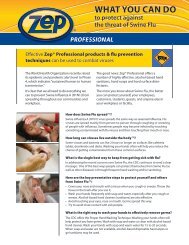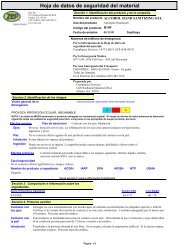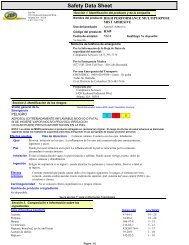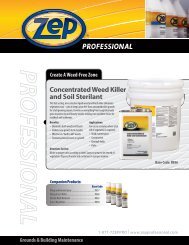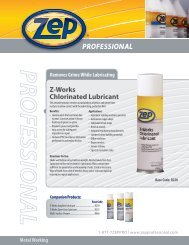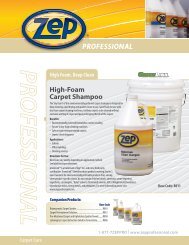You also want an ePaper? Increase the reach of your titles
YUMPU automatically turns print PDFs into web optimized ePapers that Google loves.
Page: 1/4Material Safety Data Sheet<strong>Zep</strong> Inc.1310 Seaboard Industrial Blvd.Atlanta, GA 303181-877-793-7776Section 1. Chemical Product and Company IdentificationProduct name CITRUS CLEANER RTUProduct use Cleaner. DegreaserProduct code R178Date of issue 11/02/09 SupersedesEmergency Telephone NumbersFor <strong>MSDS</strong> Information:Compliance Services 1-877-793-7776For Medical Emergency(877) 541-2016 Toll Free - All Calls RecordedFor Transportation EmergencyCHEMTREC: (800) 424-9300 - All Calls RecordedIn the District of Columbia (202) 483-7616Prepared ByCompliance Services1420 Seaboard Industrial Blvd.Atlanta, GA 30318Section 2. Hazards IdentificationEmergency overview*Hazard Determination System (HDS): Health, Flammability, ReactivityWARNING!COMBUSTIBLE. CAUSES EYE IRRITATION. MAY CAUSEALLERGIC SKIN REACTION.1 0 0NOTE: <strong>MSDS</strong> data pertains to the product as delivered in the original shipping container(s). Risk of adverse effects are lessened by following allprescribed safety precautions, including the use of proper personal protective equipment.Acute Effects Routes of Entry Dermal contact. Eye contact. Inhalation.EyesSkinCauses eye irritation. Inflammation of the eye is characterized by redness, watering and itching.May cause skin irritation. Skin inflammation is characterized by itching, scaling, or reddening.May cause skin sensitization.Inhalation Avoid breathing vapors, spray or mists. Over-exposure by inhalation may cause respiratoryirritation.Ingestion May be harmful if swallowed. Can cause gastrointestinal disturbances.Chronic effects Repeated or prolonged exposure to spray mist may produce respiratory tract irritation leading tofrequent attacks of bronchial infection. Repeated or prolonged contact with spray or mist mayproduce chronic eye irritation and severe skin irritation. Contains material which may causedamage to the following organs: blood, kidneys, lungs, liver.Carcinogenicity No known significant effects or critical hazards.Product/ingredient nameNot available.Section 3. Composition/Information on IngredientsAdditional Information: See Toxicological Information (Section 11)Name of Hazardous Ingredients CAS number % by WeightD-LIMONENE; orange distillate; citrus terpene; cyclohexene, 1-methyl-4-(1-methylethenyl)-, 5989-27-5 1 - 5(R)-MONOETHANOLAMINE; 2-aminoethanol; MEA 141-43-5 1 - 5SODIUM XYLENE SULFONATE 1300-72-7 1 - 5DIETHYLENE GLYCOL MONOBUTYL ETHER; 2-(2-butoxyethoxy)-ethanol; butyl carbitol 112-34-5 1 - 5ALPHA OLEFIN SULFONATE; SODIUM SALT; sulfonic acids; c14-18 alkane and c12-20 68439-57-6 1 - 5alkene; c12-20 alkenehydroxy; sodium saltsC12-C16 ETHOXYLATED ALCOHOLS 68551-12-2
Page: 2/4Product code R178Material Safety Data SheetProduct Name CITRUS CLEANER RTUSection 4. First Aid MeasuresEye ContactSkin ContactInhalationIngestionFlash PointFlammable LimitsFlammabilityFire hazardFire-FightingProceduresCheck for and remove any contact lenses. Immediately flush eyes with plenty of water for at least 15 minutes,occasionally lifting the upper and lower eyelids. Get medical attention immediately.In case of contact, immediately flush skin with plenty of water for at least 15 minutes while removingcontaminated clothing and shoes. Wash clothing before reuse. Clean shoes thoroughly before reuse. Get medicalattention if irritation develops.Move exposed person to fresh air. If irritation persists, get medical attention.Wash out mouth with water. Do not induce vomiting unless directed to do so by medical personnel. If affectedperson is conscious, give plenty of water to drink. Never give anything by mouth to an unconscious person. Getmedical attention immediately.Section 5. Fire Fighting MeasuresClosed cup: >51°C (>123.8°F)[Tagliabue.]Not determined.COMBUSTIBLE.National Fire Protection Association (U.S.A.)1 2 0Combustible liquid. In a fire or if heated, a pressure increase will occur and the container mayburst, with the risk of a subsequent explosion.Use dry chemical, CO2, water spray (fog) or foam.Section 6. Accidental Release MeasuresSpill Clean upEliminate all ignition sources. Stop leak if without risk. Move containers from spill area. Dilute with water andmop up if water-soluble. Alternatively, or if water-insoluble, absorb with an inert dry material and place in anappropriate waste disposal container. Use spark-proof tools and explosion-proof equipment. Dispose of via alicensed waste disposal contractor.Section 7. Handling and StorageHandlingStoragePut on appropriate personal protective equipment (see section 8). Store and use away from heat, sparks, open flameor any other ignition source. Avoid contact with eyes, skin and clothing. Avoid breathing vapor or mist. Use onlywith adequate ventilation. Do not ingest. Empty containers retain product residue and can be hazardous. Do notreuse container. Wash thoroughly after handling. Apply this product only as specified on the label.Store in accordance with local regulations. Store in original container protected from direct sunlight in a dry, cool andwell-ventilated area, away from incompatible materials (see section 10) and food and drink. Keep container tightlyclosed and sealed until ready for use. Containers that have been opened must be carefully resealed and kept upright toprevent leakage. Do not store in unlabeled containers. Keep out of the reach of children.Section 8. Exposure Controls/Personal ProtectionProduct nameMONOETHANOLAMINE; 2-aminoethanol; MEADIETHYLENE GLYCOL MONOBUTYL ETHER; 2-(2-butoxyethoxy)-ethanol; butyl carbitolPersonal Protective Equipment (PPE)EyesBodyRespiratoryExposure limitsOSHA PEL / ACGIH TLV (United States).TWA: 3 ppm 8 hour(s).OSHA /ACGIH (United States).STEL: 6 ppm 15 minute(s).Manufacturer (United States).TWA: 35 ppm 8 hour(s).Safety glasses.Recommended: Neoprene gloves. Nitrile gloves. Rubber gloves.Use with adequate ventilation. Provide exhaust ventilation or other engineeringcontrols to keep the airborne concentrations of below established levels. Wearappropriate respirator when ventilation is inadequate.Section 9. Physical and Chemical PropertiesPhysical StatepHBoiling PointSpecific GravitySolubilityLiquid. [Thin liquid]11 to 12Not determined.1.01Soluble in the following materials: cold water andhot water.Color Clear. Orange.Odor CitrusVapor Pressure 0.004 kPa (0.03 mm Hg)Vapor Density Not determined.Evaporation Rate 1 (Water = 1)VOC (Consumer)4% (w/w)
Page: 3/4Product code R178Material Safety Data SheetProduct Name CITRUS CLEANER RTUSection 10. Stability and ReactivityStability and Reactivity The product is stable.IncompatibilityKeep away from heat, sparks and flame. Reactive or incompatible with the following materials:oxidizing materials.Slightly reactive or incompatible with the following materials: acids.Hazardous Polymerization Under normal conditions of storage and use, hazardous polymerization will not occur.Hazardous Decomposition Products carbon oxides (CO, CO2)Section 11. Toxicological InformationAcute ToxicityProduct/ingredient name Result Species Dose ExposureMonoethanolamine LD50 Dermal Rabbit >1000 mg/kg -LD50 Oral Rat 1720 mg/kg -Diethylene Glycol Monobutyl Ether LD50 Dermal Rabbit 2700 mg/kg -LD50 Oral Rat 5660 mg/kg -LD50 Oral Mouse 2400 mg/kg -C12-C16 ETHOXYLATED ALCOHOLS LD50 Oral Rat 1380 mg/kg -Section 12. Ecological InformationEnvironmental EffectsAquatic EcotoxicityNo known significant effects or critical hazards.Not available.Section 13. Disposal ConsiderationsWaste InformationWaste must be disposed of in accordance with federal, state and local environmental control regulations. Consult your local orregional authorities for additional information.Waste StreamCode: D001Classification: - [Hazardous waste.]Origin: - [RCRA waste.]Section 14. Transport InformationRegulatory information UN number Proper shipping name Classes PG* LabelDOT ClassificationNot applicable.Not applicable. - IIMDG ClassNot determinedNOTE: DOT classification applies to most package sizes. For specific container size classifications or for size exceptions, refer tothe Bill of Lading with your shipment.PG* : Packing groupSection 15. Regulatory InformationU.S. Federal RegulationsSARA 313 toxic chemical notification and release reporting:Product nameDiethylene Glycol Monobutyl EtherClean Water Act (CWA) 307: No products were found.Clean Water Act (CWA) 311: No products were found.Clean Air Act (CAA) 112 regulated toxic substances: Diethylene Glycol Monobutyl EtherAll Components of this product are listed or exempt from listing on TSCA Inventory.State RegulationsCalifornia Prop 65No products were found.
Product code R178Material Safety Data SheetProduct Name CITRUS CLEANER RTUSection 16. Other InformationTo the best of our knowledge, the information contained herein is accurate. However, neither the above named supplier nor any of its subsidiaries assumes anyliability whatsoever for the accuracy or completeness of the information contained herein.Final determination of suitability of any material is the sole responsibility of the user. All materials may present unknown hazards and should be used with caution.Although certain hazards are described herein, we cannot guarantee that these are the only hazards that exist.*NOTE: Hazard Determination System (HDS) ratings are based on a 0-4 rating scale, with 0 representing minimal hazards or risks, and 4 representing significant hazards or risksAlthough these ratings are not required on <strong>MSDS</strong>s under 29 CFR 1910.1200, the preparer may choose to provide them. HDS ratings are to be used with a fully implemented program torelay the meanings of this scale.



